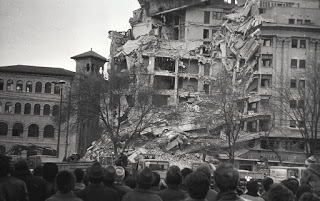Historical disasters
article
2. Earthquakes
2.4. Romania
In terms of seismicity, Romania is considered to have a moderate seismic activity, given its geographical position and its closeness to a convergent plate boundary. Being situated in a seismic active region, Romania has a history of devastating and deadly earthquakes. The Bucharest area has experienced a number of earthquakes of varying intensities, and the probability that a severe and damaging earthquake will occur is high.Photographs from the 7.2 M on the Richter Scale Earthquake in Bucharest, Romania which resulted in 2000 deaths in 1977.
 |
 |
|---|
The cause of earthquakes is clearly the geographical location of Romania which is situated close to a convergent plate boundary at the convergence of the East European Plate (EEP), Moesian microplate (MoP), and Intracarpathian microplate (IaP) which seem to meet into the Vrancea area (South-Eastern part of the country), whose active seismicity has been considered to be due to the presence of a continental unstable transform-transform-compression triple-junction. Thus, the Vrancea region, located in the South-Eastern part of the country is especially high in earthquakes and traditionally has been the epicenter of many earthquakes. Moreover, the Romanian volcanoes (the Carpathian Mountains) are active at a convergent plate margin. The Eastern Carpathians volcanic arc is 160 km long, the longest in the entire Carpathian mountain belt and it formed as a result of the convergence between two plate fragments, the Transylvanian micro-plate and the Eurasian plate.